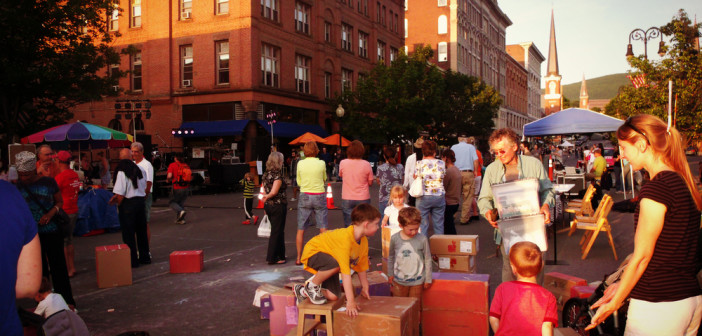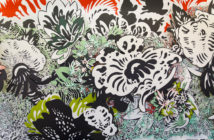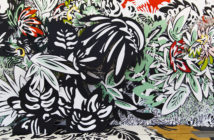North Adams came alive on the weekend of June 20th - 23rd. The town's 15,000 population increased by 60 percent as 8,000 people poured in for Wilco’s music and arts Solid Sound Festival. As far as the concept of Creative Placemaking is concerned, this is a perfect demonstration of the idea. We usually associate music festivals such as Lollapalooza, Electric Zoo, and so on, with big cities, more obvious locations of culture and heritage, and at a glance the choice of North Adams is therefore surprising. Without question, Solid Sound, held at MassMoCA, the largest Contemporary Art museum in the United States1, is carefully curated, not only to give the listener the best visual and artistic experience, but also to send a well designed message: that the Northern Berkshires are an arts destination. Solid Sound inextricably connects itself to the city of North Adams, presenting a complete arts package.
The day before Solid Sound opened, North Adams kicked off its DownStreet Art Celebration, a week earlier than usual, specifically to target Festival attendees. DownStreet Art is a public art project designed to revitalize downtown North Adams. It harnesses existing art organizations and events, transforming vacant or open spaces and storefronts into art venues for the Summer, running from 20th June until 31st October. DownStreet Art positions North Adams as a cultural haven, drawing in tourists and members of the community. Every fourth Thursday (excepting this past month), music, art events, and new exhibits open in each of the five galleries (three of which are pop-ups this year.) There are incentives offered to the public to encourage attendance, such as a free eyebrow wax at the local salon if one visits all five galleries, and so on. The event is clearly and strategically designed to bolster the local economy as a whole.
A dilemma I noticed, however, was that Solid Sound turns Mass MoCA into a fortress of sorts, due to its relative size, its enclosed campus, and the overwhelming appeal of the Festival. Attendees might not necessarily venture into downtown North Adams and interact with it. While visitation numbers downtown were higher than normal during the Festival, gallery visits were much lower than those of MassMoCA. It is estimated that somewhere close to 8,000 visitors passed through the Museum on Saturday, but numbers in galleries (at least in the pop-ups Branch Gallery and Gallery 105, which I checked with) remained in the low hundreds. Even at the DownStreet kickoff, attendance at Press Gallery, hovered around 500 people. Furthermore, many businesses remained closed on the Saturday and Sunday of the Festival, or only open for limited hours; while busier than usual, one couldn't exactly say the town was ‘bustling’, by comparison to a larger city, or to MassMoCA itself. It is important to note that when I spoke with one of the individuals involved in DownStreet Art, she did express that the businesses and folks involved with the event were very pleased with the turnout—the restaurants and bars were packed at peak hours, and there was definitely a sense of North Adams becoming branded as an arts destination.
One must question how much MassMoCA can really affect economic change in North Adams. It is important to consider that the Museum itself is a creative non-profit, and other non-profits can’t very well go ask it for funding the way they could go to, for example, Adams Community Bank. While a for-profit factor or company is a job creator, and usually invests its profits back into the local economy, a space such as MassMoCA is more focused on attracting investment and capital rather than its flow. This might be an inherent flaw of the creative economy: the almost wholly non-profit nature of the creative industry makes it impossible for direct capital to flow from larger organizations to the surrounding smaller ones; MassMoCA will not have any "profits" in the community. While businesses are focused on creating a profit that then might "trickle down" to others in that local economy, and create new wealth, the creative industry might be more focused on the transfer of wealth, rather than creation of new wealth. Does this aspect of the industry mean it is sustainable, especially in times of recession?
To address these limitations, one can see that the creative industry is also going through rapid change, to a more entrepreneurial model. Museums now have stores and restaurants, rent out spaces for weddings, parties, and concerts. Perhaps, this is the new future of the industry, and a sign of its continuing strength. It might not directly produce new wealth, but it can set off a domino effect, a whole industry centered around it—restaurants, shops, businesses, hospitality, education, health, and so on. From what I have found, new businesses have recently been established in Downtown North Adams, including a sushi restaurant, a chocolate and ice cream store, cafés, and so on, in part due not only to MassMoCA, but also to DownStreet Art's efforts. Institutions therefore can and must work together to revitalize the economy rather than compete to get preference, and events such as Solid Sound are an evolving answer to these ideas and dilemmas, and strong examples of sustainable "Creative Placemaking."
[1] MassMoCA is the largest museum of contemporary art in terms of area, and calls itself a complex/campus.
Icon image courtesy of Solid Sound Festival.



